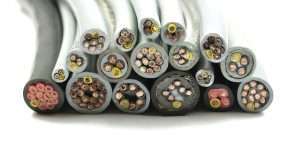Power, data & control cables undergo rigorous testing and certification processes to ensure the utmost…
Coaxial Cable for TV and CCTV: An essential guide for distributors and professionals
At Top Cable we offer our customers a complete range of coaxial cable for the reception and distribution of digital terrestrial, analogue satellite and digital television signals.
WHAT IS A COAXIAL CABLE?
A coaxial cable consists of a copper wire core surrounded by insulation, a copper braid shield and a protective jacket. The core carries electronic signals that constitute the information, surrounding the core is a dielectric insulating layer that separates it from the shield. The copper braided shield acts as a ground and protects the core from electrical noise. The core and the shield must be separated from each other. This is very important because if they were to touch each other, a short circuit would occur.

WHAT DOES THE VATC CATEGORY MEAN?
The meaning of the acronym VATC is Cable Attenuation Value. Attenuation is a decrease in the signal transmission power provided by the cable between a connection source and the cable destination. It is measured in decibels and directly influences the current, voltage and power of the signal. The higher the attenuation, the lower the quality of the transmitted signal.
Coaxial TV cables can have a VATC of category 17, 19 or 21. This means that for every 100 metres of cable length, 17, 19 or 21 decibels of signal are lost. If the cable has a higher shielding, the attenuation value of the cable will be lower.
WHAT SPECIFICATIONS SHOULD I CONSIDER WHEN SELECTING A CABLE FOR TELEVISION?
If you want to connect your television to a player such as a computer, a video game console, a DTT device, a closed circuit TV (CCTV) or any other, you will need a suitable cable for each case. At Top Cable we manufacture coaxial TV cable for industrial and domestic use.
When choosing the most suitable cable for a TV connection, the length, the intended use and the shielding of the cable must be taken into account. The screen generates a noise-free signal, preserving the cable from undesirable frequencies and waves that are transmitted through the air, generating a signal of the highest quality. There are different types of screens, depending on the needs of the installation:
- Single screen. Single screen coaxial cables are recommended for connecting the antenna to the DVB-T set or TV set.
- Double screen. They allow better signal shielding and are recommended for connecting the antenna to HD televisions. The coaxial cables manufactured by Top Cable have double shielding.
WHAT DOES RG MEAN ON A COAXIAL CABLE?
The acronym ‘RG’ can be interpreted as ‘Radio Grade’, or ‘Radio Guide’. It is a term that dates back to the World War II era, when the military made extensive use of coaxial cable and developed a set of standards to specify the different grades of coaxial cable and their applications. The term is still used today, but normatively the cables are governed by MIL-C-17.
As we have highlighted before, coaxial cables can have a domestic and also an industrial application, adapting to each type of installation. There is a wide variety of coaxial cables, among which the RG11 (M17/6), RG6 (M17/2) and RG59 (M 17/29) coaxial cables stand out.
WHAT ARE THE TECHNICAL DIFFERENCES BETWEEN RG-11, RG-6 AND RG-59 CABLE?
Coaxial cables such as RG-11 have lower signal attenuation compared to smaller gauge coaxial cables such as RG-6 or RG-59. This lower attenuation gives it the ability to transmit signal over longer distances without affecting signal quality.
HOW DO CONDUCTOR AND INSULATION MATERIALS AFFECT THE QUALITY OF THE COAXIAL CABLE?
The quality and maintenance of coaxial cable has a major impact on the quality of signal transmission. Here are some of the ways to check the quality of coaxial cables.
- Observe the integrity of the insulation.
- Measure the consistency of the insulation of the coaxial cable.
- Verify that the cable has been manufactured by a reliable supplier and that it complies with international quality standards and certifications.
HOW IS PREVENTIVE MAINTENANCE OF INSTALLED COAXIAL CABLES CARRIED OUT?
As in any type of electrical installation, in order to minimise the risk of accidents, it is advisable to carry out periodic inspections of the coaxial cables. In this way it is possible to detect any signs of damage, wear or deterioration that may affect the optimal functioning of the cable. In this way, the longevity and reliability of the electrical installation is guaranteed.
Periodic inspections can prevent costly repairs or replacements. Some signs that should be brought to our attention are physical damage, such as cuts or abrasions, as well as signs of degradation of the insulation, screen or cover, such as cracks or discolouration.
HOW TO CHOOSE A RELIABLE COAXIAL CABLE PROVIDER?
When choosing a reliable cable supplier, it is important to use an electrical distributor that offers full guarantees. Make sure that your supplier purchases coaxial cables from manufacturers with RoHS, CE, CPR and AENOR quality certificates, such as Top Cable.
If you want to know where your nearest Top Cable distributor is, please contact us here.
If you would like to become a Top Cable distributor, find out all the details of the process here.




